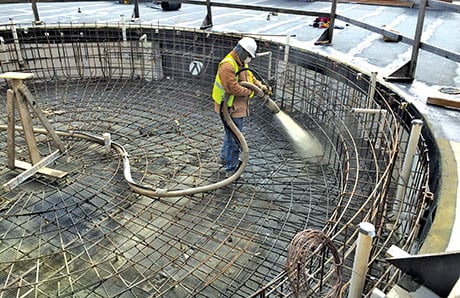How concrete (gunite/shotcrete) pools are built to last  Gunite and shotcrete are forms of pneumatically applied concrete, meaning they are sprayed on with a high-pressure air hose. Crews shoot the material over a reinforcing network of steel bars.
Gunite and shotcrete are forms of pneumatically applied concrete, meaning they are sprayed on with a high-pressure air hose. Crews shoot the material over a reinforcing network of steel bars.
As you research information backyard swimming pools, you will often encounter the term “gunite.”
But what exactly is gunite anyway? Is it different from concrete? And what’s the deal with shotcrete—is that the same thing or something else?
Gunite pools provide unparalleled levels of design flexibility and aesthetic quality.
Let’s take a look at some basics about this material, how it’s used in pool construction, how close it is to shotcrete, and the great advantages that both gunite and shotcrete deliver.
Three key elements unique to gunite pool construction
Known for its dependable structural strength, gunite is a concrete blend of sand, cement, and water that’s applied through a high-pressure hose. Once it cures (dries), gunite becomes rock hard, forming a thick, solid structure.
For decades, it has held a special place in swimming pool construction, where it is always paired with another strong building material—steel—as well as an interior finishing coat of plaster.
After a hole is excavated for a new pool, crews install a network of steel bars, known as rebar. Carefully placed at specific intervals, these metal rods form a cage-like frame that extends throughout the entire stretch of the future pool, as well as the spa if there is one.
Extra steel goes into areas requiring especially high levels of reinforcement, such as a deep end or free-standing raised wall.
Set on concrete blocks, the cage is suspended several inches in the air so it does not touch the soil beneath it. This way, plenty of space remains to be filled in by fresh gunite material.
 Both gunite and shotcrete are used to build swimming pool shells—the rock-hard vessels that can withstand pressure from shifting soil and the weight of thousands of gallons of water.
Both gunite and shotcrete are used to build swimming pool shells—the rock-hard vessels that can withstand pressure from shifting soil and the weight of thousands of gallons of water.
With the steel backbone in place, the pool is ready for gunite. Crews spray the concrete blend at high velocity onto the steel across the entire pool, creating the dense pool floor and walls.
Gunite is highly adaptable to the pool form; it produces flowing lines, various contours, depths, and shapes—all coming together in a cohesive, visually appealing structure.
After the gunite properly cures, a third material is applied to complete a gunite pool: plaster.
Composed of cement and marble dust, the smooth blend may also contain colored quartz aggregate for added durability and aesthetics. Or, high-end pebble finish may be used.
Plaster is what actually waterproofs a gunite pool, and this final coating is what everyone sees as the pool’s gleaming interior surface.
Other critical elements go into building a gunite pool, including tile, plumbing, electric, and perimeter coping.
However, what sets gunite construction apart from other types of pool is the gunite, steel, and plaster. And what sets the completed project apart is the incredible durability and design versatility that this trio provides.
What’s shotcrete—and how is it different from gunite?
What’s most important to understand here is that both gunite and shotcrete are a form of concrete.
Between the two, the term gunite is more widely used in reference to swimming pools. However, it’s worth nothing that gunite is actually a type of shotcrete.
It’s true: Gunite is the offspring of shotcrete. The only variations between the two blends are the preparation and a single ingredient.
Gunite is a dry mix—with water added to it with a hose at the job site; shotcrete is a “wet mix” that’s blended up beforehand. Shotcrete also contains some gravel, whereas gunite does not.
First, let’s look at building a pool with gunite. A truck or gunite rig brings a dry load of sand and cement to a job site.
There, the material goes into a container called a hopper. From there, the material feeds it into a mixing system known as an auger.
The auger feeds the dry gunite mix into a high-pressure hose. The hose has a nozzle and is operated by a professional known as a nozzleman.
Using an additional separate line and tip that connects to the gunite hose, the nozzleman adds water to the dry mix as it exits the hose.
Now the blended gunite mixture is wet and it’s ready to be applied to create a swimming pool shell.
Now, turning to shotcrete: The material is composed of sand, cement, and pea-sized gravel.
These dry materials go into a large truck with a huge, rotating barrel—you have probably seen these rather imposing-looking vehicles on the road before.
The barrel, which also contains water, mixes the dry material with the liquid to produce a smooth blend that will be ready for use as soon as the truck arrives at the job site.
As with gunite, a high-pressure hose is used to spray the shotcrete into the pool hole to create a solid structure.
Don’t get caught up in the distinctions between the two materials. Again, both are concrete, and both will create tough, long-lasting pool shells.
Around the country, reputable pool builders construct inground pools using either. Depending on where you live, you’ll find gunite pools, shotcrete pools, or both.
Due to various local factors, pool contractors often use one material over another.
In some regions of the U.S., gunite is dominant; in others, shotcrete is more commonly used. Or the use of each might be more evenly split.
Either way, it’s all good. What matters most, is both gunite and shotcrete are ideal for swimming pool construction.
Both create solid, monolithic structures with superior durability and flexibility for any backyard design.
Note:
Because the term gunite is so widely used in discussions about pools, from here on, this article will simply use “gunite” when describing pools built from either gunite or shotcrete.
Why gunite pools are so popular
Because it’s so versatile for design and durable for longevity, gunite has long been the standard for both commercial and residential swimming pool construction.
Millions of gunite pools across the country provide fun, fitness, relaxation, and visual appeal in residential backyards.
Thousands more provide the same at motels, hotels, schools, universities, athletic facilities, and community home developments and associations.
For a beautiful, enduring aquatic upgrade, homeowners almost always prefer a pool built in concrete over other kinds.
Fiberglass and vinyl liner pools may allow for quicker installation, lower initial cost, and limited choices for design.
However, when it comes to the finished product, they fall way short of their gunite counterpart.
With gunite, options for pool design cross the full spectrum. Whether building pools with smooth curves, sharp angles, or both, gunite delivers.
From beach entries to elevated spas, a myriad of design features can be added to boost your pool’s overall style and beauty.
You can have a private aquatic resort in virtually any size, shape, depth, and configuration that works best for your budget, backyard, lifestyle, and style preferences.
—Built to last
Along with distinctive style and ultimate design flexibility, there’s another reason that gunite is so widely used for pool construction.
Gunite provides an enduring result: a stable, steel-reinforced concrete structure that holds water and stands the test of time.
Gunite’s proven track record spans decades and all parts of the country (and globe). The key to its performance lies in its tensile strength—its ability to endure external force until it is compromised.
Along with boasting an extremely high tensile fortitude, gunite brings something else to the table: flexibility. That’s right, being flexible makes gunite perform even better in a swimming pool.

Because it’s built with highly adaptable gunite, this custom pool boasts a free-flowing shape tailored to the backyard’s configuration, as well as specialty features like a fountain shelf, integrated rock waterfall, and elevated spa with a tiered, trickling spillway.
The reason comes down to dirt—that is, shifting ground. Never entirely static, soil under and around a pool moves in place.
It contracts and expands from factors like compaction, water intrusion, freezing and thawing, and dry conditions like drought. And of course, soil changes occur from earthquakes—even tiny ones we do not realize ever happened.
The lesson here is that a pool shell needs to “give” and be able to “go with the flow.” The structure—as tough and solid as it is—must have a dual personality so it can move and expand—and do it all without cracking!
It’s this twin-set of attributes that makes gunite a superstar. The gunite shell can handle the pressure that most any backyard can dish out. After all, it’s not a coincidence that in California—earthquake country—hundreds of thousands of homes have pools that are gunite.
The same goes for commercial pools. There’s a reason it’s rare to see any pool besides gunite at a hotel or resort.
Businesses that own and maintain these properties know what works best and provides the most value. They need facilities that can be used by scores of guests and still hold up their appearance, safety, and durability.
The Takeaway: Gunite pools provide lasting beauty you can count on
With their superb resilience and all-around good looks, gunite pools provide tremendous value.
Now you understand the basics of their construction, their design versatility, and how both gunite and shotcrete can ensure a lasting upgrade for your home. It might be time to consider adding a gunite pool to your backyard.
To learn more about gunite pools and how you can get started on one, contact your local Blue Haven Pools office; you can view a national office directory here.




.jpg?width=1490&name=rock-waterfall-slide-pool%20(1).jpg)